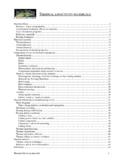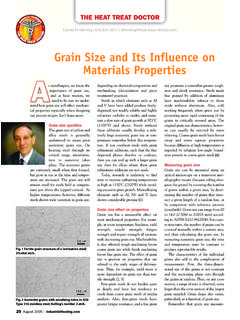Transcription of February 19'0 STRESS-CORROSION PROPERTIES s …
1 - D6-25219. o February 19"'0. STRESS-CORROSION PROPERTIES . s OF. HIGH-STRENGTH PRECIPITATION-HARDEMING STAINLESS STEELS. IN. 3. 5^ AOLEOUS SODIUM CHLORIDE SOLUTION. By Clive S. Carter Dana G. Farwick Alan VI. Ross Jack M. (Jchida o o c SEATTLE, WASHINGTON. Sponsored in Part by Advanced Research Projects Agency ARPA Order No. BTB. Ropioducod by the CLEARINGHOUSE. lor fodpral Scientific & Tochmcal Informali n Springfield V,i 22151. This document has been approved for public release and sale; its distribution is unlimited T<. //. STRESS-CORROSION PROPERTIES OF HiaH-STRENQIH, PRECIPITATION-HARDENINQ STAINLESS STEELS IN.)
2 * AQUEOUS SODIUM CHLORIDE SOLUTION. C. S. Carter, D. G. Farwick, A. M. ROBS, and J. M. Uchida ABSTRACT. The plane-strain fracture toughness K. and STRESS-CORROSION threshold have been determined for the following high-strength, precipitation-hardening steels: 17-7 PH (RH 950, TH 1050), PH 15-7Mo (RH 950, TH 1050), AM 355 (SCT 85O, SCT 1000), AM 362 (H 900, H 1000), AM 364 (H 850, H 950), 17-4 PH (H 900, H 1000), 15-5 PH air melted and vacuum melted (H 900, H 1000), PH 13-PMo (H 950), and Custom 455 (H 950). Correlations of K- with service performance, smooth-specimen test X8CC. data, and chemical composition are discussed.
3 INTRODUCTION. In the numerous Investigations conducted to determine the stress - corrosion cracking PROPERTIES of high-strength, precipitation-hardening stainless steels, smooth, unnotched specimens have customarily been tested. Hie problems associated with interpreting smooth-specimen data and translating it into design considerations have been emphasized by Brown (1,2). However, the development of nrecracked-specimen testing and data analysis in terms of linear elastic fracture mechanics has provided a more rational basis for alloy selection and information that can be directly used in design considerations.
4 Unfortunately, only a limited amount of data from precracked specimens has been reported for precipitation-hardening stainless steels. The present investigation therefore had the following objectives: 1. Establish for high-strength, precipitation-hardening stainless steels in various heat-treatment conditions the plane-strain The authors are associated with the Commercial Airplane Group, The Boeing Company, Seattle, Washington. atr M-int n lty thrtahold K-^^^ balow which atrcM-eorroalon crocking do a not occur. 2. Correlate tha Kj^g with known aaryica parfonunoa. 3. Determine whether atreaa-corroaion cracking propertiea obtained from precraeked apacioena correlate with publiahed data obtained fro aaooth apeclaena.
5 K, Exaaine the effect of oompoaition on the K. of theae ateela. lace The environment aelected waa 3*3# aqueoua aodium chloride aolution, which haa been uaed in many previoua atreaa-corroaion teata on both amooth and precraeked apecimena, and poaaibly aimulatea an aggreaaive aervice environment. The development and propertiea of moat of the commercially available atainleaa ateela were reviewed recently (3 ^); therefore, only factora eaaentlal to thia atudy are diaeuaaed here. Theae ateela generally contain 10$ to 20$ chromium, up to 12$ nickel, and one or more elementa, auch aa Ti, Al, Nb, Cu, or Mo, given in approximately deoreaaing order of atrengthening effectiveneaa (5), to promote precipitation hardening of the martenaite matrix.
6 High-atrength, precipitation-hardening atainleaa ateela may be divided into two major categoriea aemiauatenitic and martenaitic. Semi- auatenitic ateela have a carbon content of to to promote auatenite atability. They are auatenitlc in the annealed condition and, aa auch, havj good formability. Tranaformation to martenaite ia accompliahed either by a trigger anneal (TH condition) to precipitate carbldea and raiae the martenaite atart (M8) tempera Lure or by aubsero cooling below M (RH condition). The deaired atrength ia aubaequently attained by aging at 900 to 1150 ?. Unfortunately, the chemical balance needed leada to S -ferrite formation and grain-boundary carbide precipi- tation (6), which reaulta in low tranaverae ductility.
7 The carbon content of martenaitic ateela ia maintained at low lavela. Hie alloy content ia balanced to provide an eaaentially martenaitic atruc- ture at room temperature. However, increaaing the alloy content, with the exception of Co and Al, lowera M0, thua promoting retention of aua- tenlte. Also, moat ag* hardening lementa pronota j-ferrlte formation (3). High atrength ia attained by aging at temperaturea aimilar to the* . uaad for the aemlauatanitic ataela. Because of the tranaverae ductility problema aaaociated with the aemiauatenitic atainleaa ateela, most development in recent years haa been directed to the martenaitic types.
8 Steels for high-temperature applications that contain 15$ to 20$ Co to maintain elevated-temperature strength have also been developed. The propertlea of these alloys have been discussed elsewhere (7 8). MATERIALS AND HEAT TREATMENT. The chemical compositions of the steels studied in the present in- vestigation are given in Table 1 together with the form in which the steels were procured. Where possible, the heat treatments selected (Table 2) were those known to be used for aerospace applications. stress - corrosion resistance of moat of the aemiauatenitic ateela (except AM 335). was deterndned in both RH and TH conditions.
9 ' he martensitic steels were, in most cases, evaluated after aging to peak strength and after overaging. EXPERIMENTAL PROCEDURE. Round tension apeeimena ( in. in diameter) and aingle-edge- notched apeeimena (Fig. 1) were machined from the materials with their major axes parallel to the longitudinal grain direction. "Hie specimens were heat treated aa blanka and aubaequently ground to final dlmenaions. Notched apeeimena were fatigue cycled after heat treatment to produce a precrack approximately In. long at the notch root. Tenaile mechanical propertlea were determined in duplicate at room temperature using a atrain rate of to yield and to failure.
10 The plane-strain fracture toughneaa K. ^c was determined in duplicate at room temperature by loading single-edge- notched specimens (Fig. la) in three-point bending. The tests were per- formed and the reaulta analysed according to the recommended ASTM pro- cedure (9). To evaluate atreaa-corroaion reaiatance, fatigue precraoked single . edge-notched apeelmna (Fig. lb) were hydraulleally sustain loaded to selected initial atreaa-intensity K_ levela in cantilever bending using the procedure deacribed by Brown (1). Hie atreas intensity waa calculated according to the relationship given by Brown and Srawley (10).

















